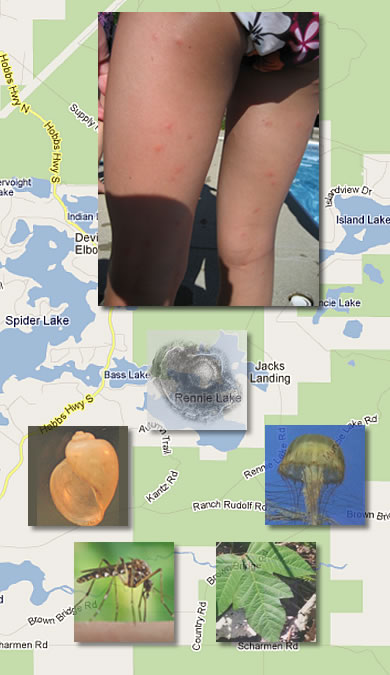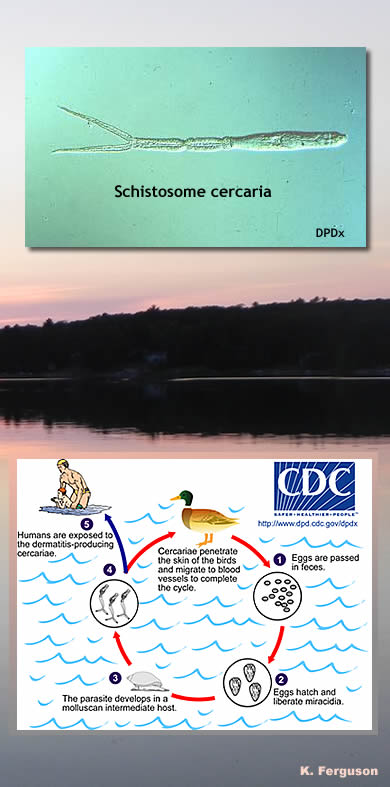Infectious Diseases Case of the Month Case #32 |
|||
 |
Five young ladies, ages eight to eleven, enjoyed a two day summertime reunion in Michigan at the lakeside home of one of their families. All five of the children had been adopted from China, and to attend the reunion some of the children had traveled from as far away as Oregon. While their parents were otherwise occupied, the girls played outdoors on the wooded property and swam in the lake. The lake was an "inland lake" not one of the three Great Lakes that border much of the state of Michigan. There were mosquitoes and blackflies about. By the evening of the first day one of the girls (a member of the host family) had developed an intensely pruritic papular rash on her exposed extremities. By the following day all five of the girls had similar rashes (see photo at left). Other than the intense prurtitis the girls otherwise felt well and did not experience fever or other systemic symptoms. At least two of the children had been previously immunized for chicken pox. The vaccine status of the remaining three children was uncertain. Direct or indirect exposure to which of the five items pictured at lower left most likely led to the development of the girls' rashes? |
||
This rash likely related to direct or indirect exposure to which of the following ? |
|||
 |
The girls had cercarial dermatitis, "swimmer's itch," due to non-human schistosomes. Cercarial dermatitis is caused by the inflammatory reaction to the penetration of skin by cercariae (see left) of one of several non-human schistosomes. Normal definitive hosts for such schistosomes may be aquatic birds (ducks, gulls, geese) or mammals including beavers, mice, muskrats, and ungulates. Upon penetration of human skin the shistosome cercaria is unable to develop further and is killed by the inflammatory response, a response also responsible for the development of the characteristic pruritic macular- papular rash. This benign eruption usually disappears in seven to fourteen days. The schistosome cycle "begins" with the deposition of eggs from a definitive host into the aquatic environment. The eggs hatch releasing miracidia which parasitize the intermediate snail host. Metamorphosis within the snail leads to the eventual release of cercariae which again seek a definitive host in which to mature to an adult trematode (see image at lower left or click here for a larger image and more detailed description of this cycle). The geographic distribution of this dermatosis is worldwide. In the midwestern United States where it is commonly seen, its incidence may be highest in the early summer with cases more likely to occur in those who swim in the morning and in shallower, warmer water. The fact that in this vignette the eruption appeared first in a child of the host family may reflect a more intense inflammatory response in someone previously sensitized to cercarial exposure. Human schistosomiasis (see case #7) in contrast is a serious disease of humans. Cercarial exposure to human schistosomes can occur in various regions of Africa, South America, and Asia with disease manifesting potentially in various hepatic, genitourinary and ectopic forms. Exposure directly or indirectly to the other items in the preceding vignette can also lead to rashes not unlike those encountered by the five girls. Chicken pox (varicella) was unlikely given the extended incubation period of this illness, the absence of a common exposure (two children came from Oregon), and the absence of systemic symptoms. The other three exposures can all cause typically summertime rashes. Poison ivy as well as its cousins, poison sumac and poison oak, can cause an allergic phytocontact dermatitis due to these plants' elaboration of the chemical irritant uroshiol. Rash due to poison ivy may often be somewhat linear and vesiculobullous. The rash due to insect bites, particularly that due to mosquitoes, would be indistinguishable from the rash the girls experienced (the insects just weren't that prevalent at this gathering!). Finally, larval forms of jellyfish and others of the phylum Cnidaria (sea anenome, sea urchins, etc.) can cause "seabather's eruption." Unlike swimmer's itch where the rash tends to be on exposed skin, the rash of seabather's eruption tends to occur in a bathing suit distribution as the larvae trapped beneath the clothing "deploy" their nematocyst stinging apparati. Jellyfish, of course, are not found in the inland lakes of Michigan. Ref: Lindblade, K.A., The epidemiology of cercarial dermatitis and its association with limnological characteristics of a northern Michigan lake, J. Parasitol 84(1), 1998 p. 19-23. |
||
| Home Case of the Month ID Case Archive | Your Comments/Feedback | ||